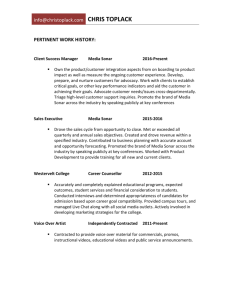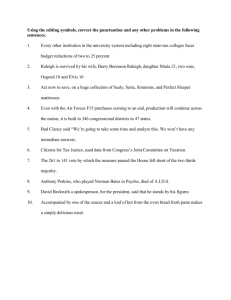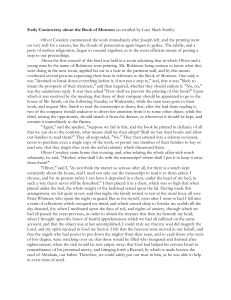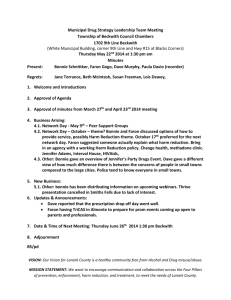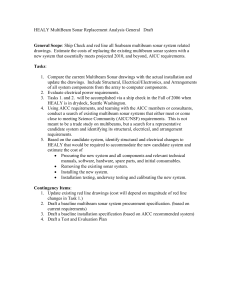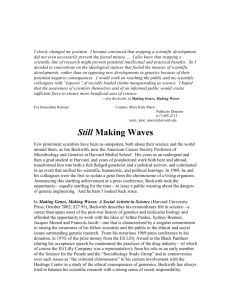doc - StealthSkater
advertisement
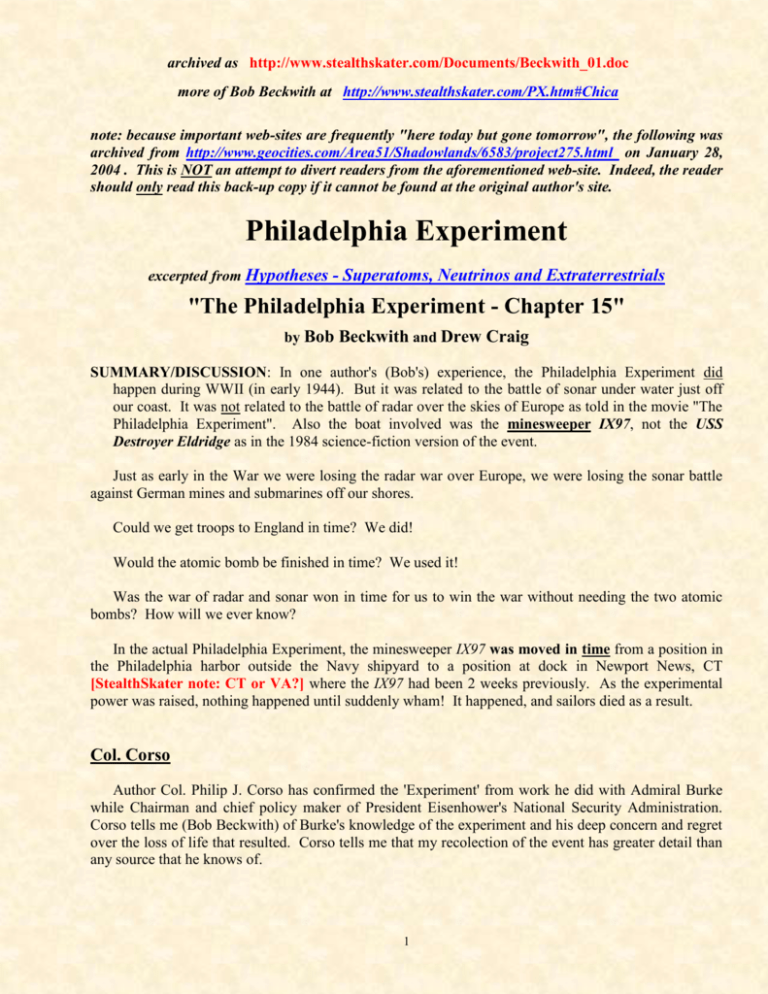
archived as http://www.stealthskater.com/Documents/Beckwith_01.doc more of Bob Beckwith at http://www.stealthskater.com/PX.htm#Chica note: because important web-sites are frequently "here today but gone tomorrow", the following was archived from http://www.geocities.com/Area51/Shadowlands/6583/project275.html on January 28, 2004 . This is NOT an attempt to divert readers from the aforementioned web-site. Indeed, the reader should only read this back-up copy if it cannot be found at the original author's site. Philadelphia Experiment excerpted from Hypotheses - Superatoms, Neutrinos and Extraterrestrials "The Philadelphia Experiment - Chapter 15" by Bob Beckwith and Drew Craig SUMMARY/DISCUSSION: In one author's (Bob's) experience, the Philadelphia Experiment did happen during WWII (in early 1944). But it was related to the battle of sonar under water just off our coast. It was not related to the battle of radar over the skies of Europe as told in the movie "The Philadelphia Experiment". Also the boat involved was the minesweeper IX97, not the USS Destroyer Eldridge as in the 1984 science-fiction version of the event. Just as early in the War we were losing the radar war over Europe, we were losing the sonar battle against German mines and submarines off our shores. Could we get troops to England in time? We did! Would the atomic bomb be finished in time? We used it! Was the war of radar and sonar won in time for us to win the war without needing the two atomic bombs? How will we ever know? In the actual Philadelphia Experiment, the minesweeper IX97 was moved in time from a position in the Philadelphia harbor outside the Navy shipyard to a position at dock in Newport News, CT [StealthSkater note: CT or VA?] where the IX97 had been 2 weeks previously. As the experimental power was raised, nothing happened until suddenly wham! It happened, and sailors died as a result. Col. Corso Author Col. Philip J. Corso has confirmed the 'Experiment' from work he did with Admiral Burke while Chairman and chief policy maker of President Eisenhower's National Security Administration. Corso tells me (Bob Beckwith) of Burke's knowledge of the experiment and his deep concern and regret over the loss of life that resulted. Corso tells me that my recolection of the event has greater detail than any source that he knows of. 1 Adm. Burke He tells me that the project continued and has progressed greatly since then. Col. Corso has kindly given permission to use his name to this important confirmation of my 55-year-old memory. The Experiment used and confirmed the principle of "Chapter 13: Divided Space". As a result, we now know that once the threshold of divided space is crossed, levitation, teleportation, and time-travel all become possible. The ability of "gifted" humans to levitate, teleport, and travel in time can now be supported, duplicated, and studied in university Biology and Psychology laboratories. Concurrently the barrier to low-energy levitation, teleportation, and time-travel can be crossed in Engineering and Physics laboratories. Results from studies with humans and studies with machinery can then be compared in recognition of the same underlying principle: Divided Space! (Note: Divided Space is what Dr. Greer refers to as the space on the other side of the Crossing Point of Light.) We cannot creep, however, using conservative scientific methods into the realm of levitation, teleportation, and time-travel any more than we could have crept slowly into setting off the bomb. History leading up to this subject starts with Nikola Tesla in 1907. According to some reports, he performed an experiment which was immediately classified. When he passed away in 1943, a custody battle evolved over ownership of his many notes. Some were taken to the Beograd N.T. Museum in Yugoslavia. Others were reported to have been seized and kept secret by the U.S. Government. Many guesses have been made as to the nature of his experiment. So why not include ours as well? It is possible that Tesla put an object at point 'A' on a table and then moved it to point 'B' on the table. By applying power to an inventive circuit, he was able to move it back to point 'A'. Turning off the power brought it back to point 'B'. This much is pretty well understood. Our guess is that he put coils under the table creating a 3-phase magnetic field around the object operating at a frequency of about 7.5 Hertz. When he applied power to the coils, the object appeared to move from point 'B' to point 'A'. And when power was removed, it moved back again to point 'B'. What he did was use the fields to move the object in time back to when it was at point 'A', and then remove power and let it come back to the present at point 'B'. The principle of divided time needs to be expanded into theories which separates the phenomena of levitation, teleportation, and time-travel. Without these theories, very small-scale experiments should be safely possible without knowing in advance just what to expect. There may be a source of information from synchronous electric power generators that is not totally enclosed so that the rotors are visible at least on one end. Hydro generators are generally of this type. Actually we have heard stories of generator rotors becoming hard to see as the generators are brought up-to-speed with their fields applied. Perhaps the phenomena is so common that operators pay no attention. The authors need to schedule a trip to a generating plant to watch a non-enclosed generator when it is started up. It is likely that Tesla was not using Einstein's principles as much as he was defying them. The Government may have convinced him to keep time-travel a secret, and he went through the rest of his life frustrated in feeling people didn't listen to him but not able to tell them of his experiments. Or perhaps he did tell some who would not believe him and considered him somewhat crazy. The answers 2 may be found in his notes if they are ever declassified. Tesla's experiment may have been the secret starting point for the Philadelphia Experiment. It is known that Tesla was interested in the possibility of transmitting alternating current power using purely magnetic waves (i.e., no transmission wires). Our hypothesis of a 6-dimensional space uses the 5th and 6th dimension for electric and magnetic fields respectively. The experiment described herein used very large currents producing huge magnetic fields with only very small voltages to drive the currents. The waves used here would have been almost purely on the 6th magnetic plane. If the stories of his experiments in 1907 are true, it seems likely that Tesla used the same fields produced by what are now conventional 3-phase currents. Now we must get into the mindset of the Bation during WWII. In about July of 1939, the Hearst Sunday supplement section of the Cleveland Plain Dealer carried an article telling of Fermi's theoretical work on nuclear fission. I remember reading about the predicted tank of water in everyone's basement with a bit of uranium heating the house for years at very low cost. Nuclear trains, planes, automobiles, and everything else were projected. And also was the bomb. If a copy of this article could be found, it would be of great historic interest! After getting an engineering degree from the Case School of Applied Science, I (Bob) went to work with General Electric. In 1942, I developed highly successful frequency shift keyed (FSK) transfer trip equipment. This eliminated one high voltage circuit breaker at each substation where generator power was stepped up in voltage for sending over a distance. The work had 'AAA' priority as a part of a nationally-coordinated electric utility crash program to connect existing generation together to supply power to Oak Ridge and to Hanford. Our use of FSK was some 5 years ahead of a second use in FSK telemetry (we had always called it "telemetering") used after the War in tes- firing captured German V2 rockets at White sands. The FSK telemetry was derived from our work by Walt Hausz and others from the GE lab at Ithaca NY who had a contract for the test firing. FSK has since blossomed into worldwide use. Remembering the Hearst article, there was never a doubt in my mind that our work was related to whatever was happening on the Manhattan Project. I was silent, however, since everyone else seemed to have missed-or-forgotten the Hearst article. Or perhaps some were playing the same discrete game of silence that I was. I wish I had kept a small article in the paper about congressman Harry Truman who demanded to know why a lot of young men at Oak Ridge Tennessee and Hanford Washington were deferred. Someone must have taken congressman Truman aside and told him it was okay since no more of his objection followed in the newspapers. In April 1945, President Roosevelt died and Truman became president. Soon after that, President Truman made the big decision to drop the bomb. There were 3 major problems for electronic engineers during WWII. One was the battle of radar -- it very nicely presented recently in an hour-long program on the Discovery Channel. Sir Watson Watt of England was given credit for the development however others were also working on it. Professor Jack Martin at Case told me rather secretly about the development in 1941 before I graduated. I remember meeting Sir Watson Watt at an AIEE winter power meeting in New Your City shortly after the War ended. 3 A second problem was the making and breaking of cryptographic codes which were always kept very secret. There are few secrets anymore with most principles of cryptology available in technical papers readily available to anyone with the smarts to understand them. The only truly secret code may be quite simple but one requiring the receiving party to carry a decrypting message with him. The most elemental code is a '1' or '0' meaning 'yes' or 'no'. But what is the question? Or the question is wellknown, but which is 'yes' -- the '1' or the '0'? A third -- also kept quite secret -- was the battle, using sonar against German submarines and mines. Our sonar was all made by the Submarine Signal Co of Groton, CT. I remember working with engineers from Sub Signal. They bragged about furnishing all of the sonar to the German and Japanese navies. As a result, both the Germans and the Japanese had an earlier, lower frequency version than the one we were using. Neither enemy country had developed sonar technology and couldn't catch up with ours during WWII. The older technology used essentially electromagnetic (EM) 'big loudspeaker' technology. And our newer heads used a very secret barium titanate transducer. These sonar heads could be extended downward from surface ships much as an "upside down periscope" and generally built in place on submarines. These EM heads operated at top frequencies of about 15 kilohertz. On the other hand, ours used newly developed barium titanate transducers operating with top ranges above the audible band at about 26 kHz. We could hear them, but they could not hear us! In late 1942, the success of the FSK power line carrier equipment attracted the interest of people at Bell Telephone's Muray Hill Laboratories near Morristown NJ. In a trip by my supervisor at GE, Ed Kenefake, and myself to Bell Lab, we learned of the problem of the bottom anchored German mine with its magnetic detector. As I remember, one meeting included a nationally known scientist. He took on the problem of the mine since it seemed we could lose the War by not being able to get troops to England before the development of the bomb was complete. The Germans developed a mine towards the end of WWI that was set off without necessary physical contact by detection of the magnetism of a ships steel hull. We were shown the magnetic detectors which involved a spring loaded solenoid with a permanent magnet floating against the spring. Between WWI and WWII, we had developed minesweepers that set these off using cables hanging along the sides of a surface operating minesweeper boat. The cables carried a low-frequency AC current at the resonant frequency of the solenoid and spring. The frequency was in the 5-to-8 Hertz range. This caused the mines to detonate far enough away from the minesweeper so as generally not to cause damage. Then at the start of WWII, the Germans surprised us with a mine anchored to the bottom that would not explode when the detector was activated by the minesweeper but first would rise to the surface just in time to get the minesweeper. This was often fatal to our minesweeper and became a major problem in keeping our shipping lanes open. I don't remember how these mines were laid by the Germans. But most likely they were from submarines just off the U.S. coastline, far removed from the radar war over Europe. The actual fuse was quite sophisticated in that it would count ships before releasing the mine to the surface. The intent could have been to try to get the minesweeper or perhaps a troop carrier as a more important target than supply ships. Ed Kenefake and I visited Bell Laboratory in late 1942. The new problem of the bottom anchored German mines was studied, and it was hoped that FSK sonar would detect the mines at a sufficient 4 distance to find and destroy them. After all, we were enthusiastic about the excellent results that we were getting with the very new FSK technology applied to power line carrier equipment. An experiment was carried out early in 1943 in a very secret lake and unfortunately found out that the FSK sonar didn't work. The sonar head ran along a track in the lake. Using the FSK sonar, the head would run up and touch a dummy mine without seeing it! The very secret lake was found by following one's way through the woods beyond a particular mailbox along a rural road outside Boonton NJ. One very helpful mail-carrier helped us find the lake by telling us where this mailbox was where he left mail for the laboratory. There was no evidence of a road whatsoever. We simply followed the only possible path between trees having been told vaguely how to do this. The lab at the lake was operated by Bell Laboratories with Dr. Horton as our technical director. I remember Dr. Vannevar Bush being mentioned as the "big man" in charge. Einstein and Tesla were also mentioned as being involved. The 'bomb' wasn't ready, and it was feared that the German submarine/mine problem might cause us to lose the War before the bomb could be used. During that first visit, we did hear of a program to quickly move a minesweeper out of the way when a mine was detected by sonar as rising from the bottom. After failure of the FSK sonar, we received a continuing contract to develop frequency-modulated sonar at 26 kHz for surface-to-surface and surfaceto-submarine communications. This was potentially a secret means of communications since the Germans couldn't hear 26 kHz and might not know of its presence. Even if they did, there were no 26 kHz equipment on the German submarines. The FM communications was to be tried out at a laboratory facility at the New London, CT Navy base. For our communications experiments, we used the Sardonix -- a luxury yacht converted for sonar work and the minesweeper IX97. The IX97 had degaussing cables hanging over the port and starboard sides of the boat. A third cable was supported on masts over the top of the boat. The officers took their ships where we needed them to go to carry out our experiments. They had little involvement in the experiments except to volunteer to judge their ability to talk with the communications noise and distortion that was always present. I was issued the civilian pass 'SHIPS 3777' (shown in Fig. l5.la) giving me access to government and military facilities and especially to come aboard surface ships and submarines as required. The pass also got me my first ride on an airplane. It was on a DC-3 on a flight to visit Hanford, WA (note: plutonium processing) for work not related to the story here. At General Electric, we developed equipment for FM voice modulation of 26 kHz sonar 'heads' for ship to ship to submarine voice communications. These were tested from June 16 to July 7, 1944 at the Underwater Sound Laboratories at the New London, CT Naval base. Figs. 15.2a through 15.2e show my expense account for the trip. Note the reference on the page for June 26 to 15,000 yards communications between the Sardonix and the IX97 using FM. Also note the lunch charges of 45 and 50 cents for meals on the Sardonix when at the dock with no charge on days at sea. Dr. Horton and I usually traveled with the Sardonix where we were always guests of the officers. No food could have been better. I remember the toast consisting of a loaf of bread with the crust removed and toasted as a loaf on all 4 sides so that just the edges of each slice were brown. This was saturated with butter as a loaf and served with 1cube of butter. It was about the only butter that I saw during WWII! 5 On June 27, Dr. Horton appeared with a Bell Lab single sideband transmitter-and-receiver converted for the 26 kHz we were using; saying "Today we are going to test SSB." We did and it worked better than FM for a reason that surprised us both. On an oscilloscope, the distortion of the FM and SSB were about the same. The difference was that the SSB distortion was linear. Even when the voice changed between "rain-barrel" to "dolphin squeak" quality, the meaning of the messages was recognizable. With FM, the distortion was non-linear and reduced the voice quality to unintelligible. I graciously conceded that Dr. Horton -- our boss -- was very correct in his choice of single sideband. I had long technical discussions with Dr. Horton about the merits of FM and SSB for the task at hand. Our Bell Lab supervisor was Vic Graff … and I must pause to tell his story which may never be recorded otherwise. Before the War started, Vic was testing a Goodyear blimp with a prototype radar mounted on nylon cords glued to the air and gas bags between the upper gas filled portion of the blimp and the lower air filled portion. Air was pumped in-and-out of the lower part of the blimp in order to go up or down. Before the submarine nets were closed at the entrance of Long Island Sound, it was found by sonar that a German sub had entered the sound waiting for the war to start. On an experimental run one evening, the sub was found on the surface charging its batteries. It immediately dove; however. Te blimp shut off its engines and drifted waiting for the sub to run out of air and to surface. Shortly before the time expected for the sub to have to surface, a vacuum tube in the radar quit. Vic stripped to his shorts and crawled out on the lower fabric, changed the tube, and got the radar working. Very soon after the repair was made, the sub surfaced. As soon as the sub surfaced, it was picked up again on the blimp's radar. The blimp drifted just over the unsuspecting sub while Vic and others opened the door and rolled bombs -- brought along 'just in case' -- out the door sinking the sub. I can remember Dr. Horton telling us about a short trip to Pearl Harbor just before our June, 1944 experiment and telling of his ride on a submarine while there. It seems the sub got stuck in a 'bow up' situation and had difficulty getting the ballast tanks straightened out so as to get horizontal again! In appreciation for the work that I did, Dr. Horton arranged for me to go to sea on a sub-hunt mission on Monday, July 3. This turned out to be a game of 'Our' sonar vs. the German sub sonar. Our boat made no contact during the day. But I well remember the return to base in the evening. We were entering the narrows leading to New London harbor where ships had to proceed one after another. Our sub was coming in on the surface and I was outside watching when suddenly a sub surfaced just ahead of us, cutting us off. Our skipper had to reverse props fast to avoid a collision. It seems that the other sub was French and had a broom tied to the periscope -- the recognized indication of a kill. The bars that evening were full of French submarines that could do no wrong. Unfortunately, while I found myself always well-accepted when working with the Navy personnel of all ranks, I felt very much out-of-place in the bars in the evening. Not really any place for a civilian. The movie "The Philadelphia Experiment" stated that the experiment was for the purpose of making a ship invisible to radar. Radar was not a major problem to the Navy -- submarines and the new type of German mine were, however. It appears that the true 'Philadelphia Experiment' was planned in part at least by Dr. Horton and others at Bell Lab and people at the underwater sound lab that we worked with in the communications 6 experiment. The IX97 must have been the minesweeper involved (since what other reason would there have been for the third overhead 'degaussing' cable?). The amazing happening -- just a few months before our experiment -- was the constant scuttlebutt conversation during meals and idle time as our boats moved in and out of the New London harbor. The stories were about the disappearance and movement of the IX97 and disturbing results that led the skipper and experimenters to quickly shut down the experiment when they suddenly found themselves at the dock in Newport News. Navy operators and undoubtedly at least one civilian in charge of the experiment may have been completely enclosed in the inner ships cabin space and 'went along for the ride' with no ill effects. The IX97 may have stayed in Norfolk long enough for those frightened operators of the experiment -enclosed in the space -- to see where they were and suddenly turned off the power bringing the ship back to Philadelphia yards. Unfortunate sailors on deck -or- the dock must have been partly moved in time, giving them the mind disturbing space separation of Fig. l5.lb. One most unfortunate mate fell from the deck to a position where he was trapped in the steelwork. Part of his body was inside and part outside of a cowling just forward of a port side cabin door. There was fresh paint on the inside and outside of this curved cowling. The main cabin formed the research room housing our experimental gear. The bridge was above us. A small room towards the stern housed three special looking generators motor driven from ships power. Controls for these generators were in the back of the main cabin. The IX97 was very cramped, whereas the Sardonix was deluxe with a lounge, kitchen, officers mess, and guest bedrooms. More sophisticated equipment may have been involved in preparing the minesweeper than that described here. I had the sense of a quick experiment gotten together in a matter of a few months and must have been rather simple addition to the 'standard' minesweeper. Since we needed all the minesweepers we could get into active service, it surely was the IX97 which made the 'time trip' and was kept out-of-duty a few months longer for our experiment with FM/SSB communications. I believe 3-phase currents were placed through the wires at a low frequency. This frequency could have been at one of the Earth's resonances recognized by Tesla and first measured by Schulman. The frequencies were approximately 7.5, 14, and 21 Hz. I believe that the generators operated over this range of frequencies. Both in spaceships per HYPOTHESES and in the Experiment, this twisting field must be necessary to break the field of strong force lines and create an inner space separated from Universal space. Once separated, the inner space containing the ship apparently moved about 2 weeks back to a time when the ship was berthed at Norfolk, VA. As they gradually eased the power up, the experimenters found that lower power levels had no noticeable effect. Suddenly a threshold was crossed and wham! -- they traveled back 2 weeks in time instead of the desired 15 minutes-or-so needed to get out of the way of a mine. Actually, they may have hoped just to levitate-or-teleport and did not recognize the possibility of time-travel. The idea of a discontinuity in the power level vs. travel function fits perfectly in support of the divided space hypothesis of "Chapter 13". As the current level in the 3 cables is increased, force lines begin to tear between the ship and Universal space. Only when the level reached the point that all lines were broken was the IX97 free from the pull of the Earth and the time of the present. Once free, the boat was free to suddenly go wherever it is that things within a divided space go. In the case of the IX97, that place was 2 weeks back in time to the place where it was at berth in Newport News. Turning the power 7 off when the skipper saw what had happened reconnected the divided space to Universal space, jerking the boat back to the Philadelphia Navy yard harbor. The return of the IX97 to Philadelphia was within seconds of the time it left -- not in 1984 as in the science-fiction version released to movie houses in 1984. It could be that the jump point uses less energy if the frequency of the rotating magnetic field is synchronous with the Earth's Schulman resonant frequency. Tesla may have known of the relationship of the Earth's resonance but not to the depth of predicting the results of the 'Experiment'. Besides, Tesla passed away in 1943 and may not have been personally involved in the experiment. The frequency may have been varied along with the power level. With the power up and nothing going on, a small change in frequency may have moved into a well of high sensitivity equivalent to, say, a 10-fold increase in power. The 'Q' of the Earth's resonances may be known to some readers and may well be between 10 and 100. The size of the 3 generators in the rear of the IX97 were about that of a 50-horsepower 60-Hz motor. Scaled down to 7.5 Hz, the power used may have been about 15 kw. Let's assume a weight of 1,500 tons for the 1X97 and one kW equivalent to one horsepower. This gives l5xl03watts/3xl06 pounds = 5 milliwatts-per-pound. This is exactly the order of magnitude one can assume for a human who can levitate and teletransport without "frying their brain"! And so another piece of the puzzle of HYPOTHESES fits together! It seems clear that the power used was far greater than needed IF the phenomena were only better understood at the time. All that was intended was to move the minesweeper a mile-or-so out of the way of the mine, corresponding to a time movement of a few minutes. It then could be kept there until the mine surfaced and was destroyed. Of course, those details were not worked out since first it was necessary to find out whether the ship could indeed be quickly moved. One must remember that at the time, we were losing the War and especially a lot of shipping of material and troops to England. There was only time for one quick experiment as the minesweeper was vitally needed using the older technology with the expected high fatality rate. Knowing what was known after the 'Experiment', the sailors on the deck could have been either sent off the ship or back inside before removing power in Newport News. We didn't know, however. The sailors who were injured by the experiment had little choice which could have improved their chance of survival. The Philadelphia Experiment was much like the atom bomb -- it could either explode with a very large bang or it could fizzle. Some very forward-looking scientists starting with Fermi realized that. As a result, the Manhattan program was organized from the start on the grand scale required. The bomb program could not creep in the methodology still followed by conventional Science from a small bang in a test tube and gradually building to a bang of the size desired. Likewise, neither can the jump into divided space be made by the conservative scientific approach. The Philadelphia Experiment must send a message to the free scientific world that profess all progress as creeping carefully along a path a step at-a-time with careful peer approval of each step. They will never reach the world of levitation, teleportation, and time travel that way! HYPOTHESIS: Movement of a space into a divided space may be accomplished by creating a rotating magnetic field within the space. Separation of the divided space will occur suddenly above a line which is a function of the strength and the frequency of the field. The shape of the line will be that of a simple resonance of a cavity which in this case is the resonance of the Earth's atmosphere. Once the space is divided, objects within the space may levitate, teleport, or move in time. Parameters controlling the mix of these effects are unknown to the authors at present. 8 The authors suggest that the effect of the rotating magnetic field is to create a vortex in the neutrino field. We suggest that "gifted" humans produce the vortex by causing the DNA molecules in the body cells to form a spiral configuration. The neutrinos follow this configuration in sufficient number to create the separated space. Using nanotechnology, it may be possible to create a curved surface of tiny moveable heavy metal surfaces so as to create a divided space that can be switched on-and-off by control of the moveable surfaces. HYPOTHESIS: If 2 rotating magnetic fields are operated in synchronism with one moving clockwise and the other counterclockwise, objects within one such space can be moved to the other space when power is applied. This would be the fundamental principle of operation of the teleporter stations said to be operational between Eglin AFB (Florida) and a base in Australia. It may be that the bodies of the sailors on the deck of the IX97 had become separated into a number of isolated spaces as shown in Fig. 15.3. Here, the areas marked by % are in a first zone, by $ in a second, by # in a third, by + in a fourth, by @ in a fifth, and in * in a sixth. If so, heat and nerve signals could not flow across the dividing boundaries. It is easy to visualize the disruption of the functioning of a body so divided. QUESTION: Is the drastic effect experienced by sailors participating in the Philadelphia Experiment related to conditions of mental patients in general? Could something be learned from reports of the experiment if they could be declassified? Surely this 54-year old information could now be made available to the mental health industry if requested for possible use in the free portion of our scientific community. HYPOTHESIS: If an effect as shown in Fig. 15.3 can be produced magnetically, surely some physicist can find a way to recouple all of the strong force lines within a human body. Intuitively, this seems no more difficult than a cat scan. If this is found to be a factor in mental illness, the procedure would certainly be beneficial. A procedure should be possible that is essentially without risk; surely so as compared to electric shock therapy. I clearly remember the scuttlebutt among those of us working together in New London concerning the experiments. And I had no reason not to believe the stories which included men trapped in steelwork and men with very serious mental disorders. The mealtime and free time conversations may or may not have included Dr. Horton, but I believe that some did. As to the validity of the scuttlebutt concerning the ship moving experiment, I can only say that jokes of this kind simply were not made up during the War. Besides, how could one hoax a story involving so many people? The Experiment could well have been planned and carried out by civilian scientists with little involvement of the Navy, as with the work in which I was involved. Fig. 15.2(a) through (d) show my expense account book for the trip as evidence proving my work at New London. There seem to be no rumors of the technique being developed and used during WWII. However, the Philadelphia Experiment surely was not forgotten. Where has this knowledge lead in the 50 years since the end of WWII? The magnetic mine is long since obsolete or -- if not -- highly refined. The effect 9 noted on the minds of the sailors near the minesweeper during the experiment and as illustrated by Fig. 15.3 may well have been independently developed into an insidious offensive anti-personnel weapon leaving little or no trace of its use. Note: there were actually three USS "Eldridge"s. However, the vessel that was involved in the Experiment is still in storage in the U.S. with the cable marks still on the sides. And one of the "Eldridge"s was indeed sold to the Greek Government as the myth has it. It is also strongly rumored that the results of this experiment will be de-classified in 2002. (c) February 14, 1998 Robert W. Beckwith 10 Born in 1919, Bob Beckwith is an ex-General Electric Electrical Engineer who was also manager of the computer section of their Electronics Lab in Syracuse for 6 years. He holds 5 patents establishing the principles of frequency shift keying (FSK), and several other patents. The book Hypotheses - Superatoms, Neutrinos and Extraterrestrials is self-published and can be obtained from the author at: Robert W. Beckwith 2794 Camden Road Clearwater, Fla 33759 Tel: (813) 726 5411 rwbe@tampabay.rr.com Beckwith Electric Company 6190 118th Avenue, North Largo, Florida 33773-3724 (727) 544-2326 http://www.beckwithelectric.com/ Biography of Robert Beckwith (access "Links" at http://www.beckwithelectric.com/about.htm ) Robert W. Beckwith CEO - Beckwith Electric Co. General Manager – Beckwith Electric Research, Largo, Florida ● 50-Year World Leader in the Electric Power Industry ● Company Founder ● Honored Scientist, Inventor, Researcher, & Consultant ● Life Fellow member of the IEEE ● MEE Syracuse University ● BSEE Case Western Reserve University Background: In 1942, Mr. Beckwith invented Frequency Shift Keying (FSK) while working for the General Electric Power Line Carrier Section in Schenectady NY. This was applied to protection of generator transformers in the interconnection of transmission lines to supply power for the Manhattan Project. He worked with Dr. Edward Teller and Bell Labs' Dr. Horton in developing secure voice modulated 26 kHz sonar for ship/submarine underwater communications. He worked with the Underwater Sound Laboratory at New London CT researching counters to German mines. From 1955 to 1961 Mr. Beckwith was Manager, Computers & Communications, General Electric Company Electronics Research Laboratory, Syracuse, New York where the following significant achievements were made: 11 ● 26KHz Spread-Spectrum Sonar ● “Machine Tool Director” for manufacturing steam turbine buckets to mathematically generated shapes, which improved turbine efficiency 1%. ● Over-the-Horizon Radar (OTHR) with a 2,000-mile range, under contract to Navy Research Labs (NRL), Washington, D.C. ● First Polaris Digital Fire Control system, developed in cooperation with Dr. Stark Draper & David Gold to work with Draper’s gyro-guided “bird”. The fire control system used the first point-contact germanium transistors. ● In 1956, initiated change of the ERMA computer for the Bank of America from the vacuum tube wired program design of Stanford Research Laboratory to a new transistorized design using programmable drum memory. Was responsible for the first phase of the new design while the GE Computer Dept. was formed to build 30 machines for the bank. From 1961 to 1967 Mr. Beckwith was Manager of Utility Systems at Gulton Industries where he developed an early-transistorized Supervisory Control & Data Acquisition (SCADA) system for the Bureau of Reclamation. He also developed the first transistorized synchronizer for generators, and for three electric utility tie points between the eastern and western USA power transmission grid. In 1967 Mr. Beckwith founded Beckwith Electric Company (BECO) and developed the BECO generator and line synchronizers after buying his patents from Gulton. In 1970 he developed the first transistorized control for underload tapchanging transformers for electric utility use. In 1993, Mr. Beckwith oversaw recovery and reconstruction after a devastating Florida tornado destroyed the main BECO facility. In 1997, under his innovative guidance, BECO again led the industry by introducing its “Autodaptive" system of tapchanging transformer and distribution line capacitor controls for hands-off automation of distribution substation Volts, Watts, and VArs. In 2000 Mr. Beckwith founded Beckwith Electric Research (BER), a division of BECO, which conducts research at the forefront of present-day engineering and physics. Robert W. Beckwith and the company he founded in 1967 -- Beckwith Electric Company (BECO) -- are world leaders in the electrical power industry. Mr. Beckwith is a former member of the American Institute of Electrical Engineers (AIEE), and the Institute of Electronic Engineers (IRE) that combined to form the Institute of Electrical and Electronic Engineers (IEEE). Mr. Beckwith and his wife Evelyn have 4 adult children, are active in local community affairs, are patrons of the arts, and reside in Clearwater, Florida. Clearances: Held TOP SECRET clearance at General Electric, Co. 12 Patents Granted: Carrier current products were developed at GE during WW-II, which carried “AAA” priority as vital for the Hanford and Oak Ridge, TN nuclear research facilities. These established the first use of frequency shift keying (FSK) as the basis for the widely used FSK ever since. The following five patents were held up for writing and issue due to WW-II: DATE Feb 15, 1949 Nov 21, 1950 Aug 13, 1957 Jan 27, 1959 Jan 20, 1970 July 20, 1971 Jun 28, 1971 Aug 24, 1971 Mar 07, 1972 Mar 20, 1973 Jan 01, 1974 May 13, 1975 Jan 25, 1978 Mar 17, 1981 Jan 12, 1982 Dec 14, 1982 Jul 30, 1996 May 24, 1994 Jun 25, 1996 Aug 06, 1996 Dec 12, 1996 Mar 25, 1997 Jul 08, 1997 Jun 30, 1998 Aug 24, 1999 Apr09, 2002 June 25, 2002 TITLE “Frequency Response Circuits” “Frequency Shift Oscillator Circuit” “Frequency Response Circuits” “Method and Apparatus for Transmission of Intelligence” “Power Transmission Line Switch Control System” “Gram I” “Telemeter Spike Suppressor” “DC-DC Converter” “Voltage Balance Relay” “Regulator Control” “Phase Condition Indicating Circuit” “Overcurrent Relay Circuit” “Synchronous Check Relay” “Power Transfer Relay” “Method for Transferring Power in a Synchronous Mode To a Motor Bus” “Method and Apparatus for Providing Signals from LTC Transformer to Electrical Devices” “Distribution Circuit VAR Management System Using Adaptive Capacitor Controls” “Method and Apparatus Providing Half-Cycle Digitization Of A.C. Signals by an Analog-to-Digital Converter” “Load Tapchanger Transformer Paralleling by Daisy Chain Comparison of Load Currents” “Apparatus and Method for Sampling Signals Synchronous With Analog-to-Digital Converter” “Microcontroller-Based Tap-Changer Controller Employing Half Wave Digitization of A.C. Signals” “Fiber Optic Terminator with Electrical Input/Output” “Multifunction Adaptive Controls for Tapswitches and Capacitors” “A Method for Obtaining the Fundamental and Odd Harmonic Components of A.C. Signals” “Two-Way Packet Radio Including Smart Data Buffer and Packet Rate Conversion” “Synchronous Linear Machine for Protective Relaying” “A Synchronous Extremely Low Frequency (ELF) Receiver” 13 PATENT NO. 2,461,956 2,531,103 2,712,600 2,871,463 3,491,248 3,594,637 3,566,909 3,601,680 3,648,112 3,721,894 3,783,341 3,883,782 4,218,625 4,256,972 4,310,771 4,363,974 5,541,498 5,315,527 5,530,338 5,544,064 5,581,173 5,615,292 5,646,512 5,774,366 5,943,202 06,370,483B1 06,411,913 Patents Pending: DATE Apr 15, 1998 Jul 20, 1999 Jan 08, 2000 May 17, 2000 Dec 12, 2000 Jun 02, 2001 TITLE “Space Communications Using Separated Information Globes” [Title changed to: “Infinite Speed Space Communications Using Information Globes”] [Issue fee paid Sep 26, 2001; patent should issue on/before Jan 2002] “A Neutrino Driven Battery Charger for Electric Automobiles” [Title changed to: “Direct Uses of Neutrino Energy”; title further changed to: “A Neutrino Light to Photon Light Converting Matrix” ] “Radio as the Man/Machine Interface for an IED” [Title changed to: “Expanded Capabilities for Wireless TwoWay Packet Communications for IEDs”; title further changed to: “Wireless Hub and Protocol Converter”] “Method of Making Carbon-14 from Nitrogen-14” “A Wireless Module Using a Simplified Prism II System” “Apparatus for Obtaining the Earth’s Resonant Frequency And Using It for Power Generation” [Title changed to: “Apparatus for Generating Power by Levitation of a Mass Bound to Piezoelectric Material”] PATENT NO. 09/059738 60/093477 09/479605 09/572615 60/255,046 if on the Internet, Press <BACK> on your browser to return to the previous page (or go to www.stealthskater.com) else if accessing these files from the CD in a MS-Word session, simply <CLOSE> this file's window-session; the previous window-session should still remain 'active' 14
